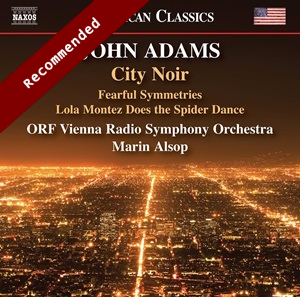
John Adams (b. 1947)
City Noir (2009)
Fearful Symmetries (1988)
Lola Montez Does the Spider Dance (2016, rev. 2020)
ORF Vienna Radio Symphony Orchestra / Marin Alsop
rec. 2022, Grosser Sendesaal, ORF Funkhaus and Grosser Saal, Musikverein, Vienna, Austria
Naxos 8.559935 [69]
It is no surprise that Marin Alsop has a genuine affinity for John Adams’s orchestral output: she has quite a reputation in other American music. For example, her excellent interpretations of Leonard Bernstein’s works are at least as good as those of the composer himself. She has two other discs of John Adams’s music, with rave reviews, but those appeared nearly twenty years ago, so here is a timely new release.
City Noir, a tribute to Los Angeles commissioned by the city’s Philharmonic and other organizations, aims to depict the darker side of the city. Frank K. DeWald’s booklet notes say that the work “evokes a similar mood and feeling of tone” to film noir, without any stylistic resemblance to the soundtracks of those films. The first of three movements, “The City and its Double”, powerfully captures the spirit of the dark, even menacing, Los Angeles night. There are jazzy elements, as in the rest of the piece, with a prominent part for alto saxophone and the appearance of a jazz drummer. The orchestral texture can be dense with heavy strings, prominent woodwinds and percussion.
The second movement, “This Song is for You”, follows without a break. As DeWald points out, this kind of Nachtmusik “opens with hazy strings, played without vibrato”. Again, the saxophone plays a major role, as later does the trombone. A large percussion section includes bells and tuned gongs like in Balinese music. The music creates a rather mysterious, unsettling mood. After a solemn, dark opening, the finale, “Boulevard Night”, lightens up with bells and timpani before a bluesy solo trumpet enters. The solo reminds me a lot of that in the Doctor Atomic Symphony, taken from that opera. The music becomes jazzy and rhythmic, with much drumming, not far removed from Bernstein’s West Side Story. There are more saxophone solos and trombone slides. The brass, particularly the horns, have a field day before the work just stops.
Adams composed City Noir for Gustavo Dudamel and the Los Angeles Philharmonic. Dudamel’s recordings are the chief competition for Alsop. He recorded it with the LA orchestra, but I am more familiar with his later account with the Berlin Philharmonic on the orchestra’s label; he is formidable, and has one of the world’s greatest orchestras at his disposal. Still, Alsop has little to fear in comparison. Both performances are superb, and superbly recorded. Dudamel seems to favour the solo saxophone a bit more, treating it as a soloist somewhat in the manner of a concertante, whereas Alsop makes them better integrated in the orchestral texture. Both approaches convince, and I would have a hard time choosing one over the other. It is high praise for Alsop and her musicians that the Vienna Radio Symphony can challenge the Berlin Philharmonic in this music.
The other major work here, Fearful Symmetries, emanates from the composer’s minimalist period. He conceived of the piece shortly after he composed his first opera, Nixon in China. The more repetitious nature recalls his Chairman Dances, derived from the opera, and his very popular Short Ride in a Fast Machine. According to DeWald, Fearful Symmetries “might well be subtitled ‘Long Ride in a Fast Machine’, due to its strong, motor pulse throughout its nearly half-hour duration”. Yet, it easily holds one’s attention, especially in this outstanding performance. I compared it with the authoritative one on Nonesuch, by John Adams and the Orchestra of St. Luke’s. Alsop’s performance is better recorded and more exciting than the composer’s. This is partly due to her more characterful account and also to a seemingly broader dynamic range. With its big-band orchestration, including heavy brass, winds, synthesizer and percussion, it makes a powerful impression here. I was not bored for a minute, whereas I found Adams’s performance rather harder to endure.
Lola Montez Does the Spider Dance was composed to honour Marin Alsop, for whom Adams has the greatest respect and admiration. It receives an authoritative account in the premiere recording. Adams apparently thought enough of the piece that he incorporated it into his opera, Girls of the Golden West. The title refers to an Irishwoman with the pseudonym Lola Montez, who was a well-known dancer in the middle of the nineteenth century. The work depicts her being attacked by spiders as she dances until she stamps them out, the last with a thud by the orchestra’s lowest instruments. There is an extensive part for solo clarinet. At under six minutes, the rhythmic verve, memorable themes and colourful orchestration, would make for a great concert opener.
In every respect, this disc is a must for all fans of John Adams and of Marin Alsop. The performances and recording are terrific, and the programme provides a good range of the composer’s style. Neither of the major pieces has been recorded too much. The addition of a new one makes the proposition all the more enticing.
Buying this recording via a link below generates revenue for MWI and helps us keep free access to the site




















